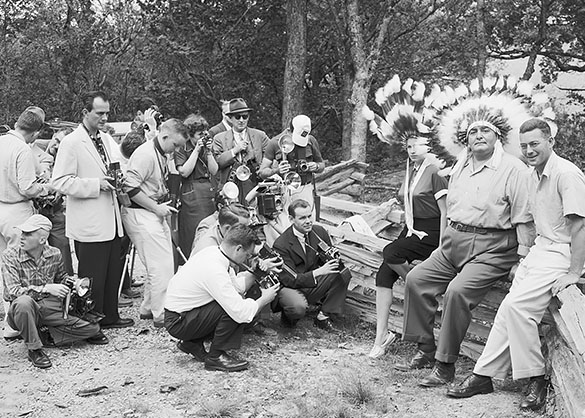
Today is the sixth annual World Photography Day, established to honor the French government’s declaration on August 19, 1839 that made the daguerreotype process “free to the world.” The French government acquired the rights to the process from Louis-Jacques-Mandé Daguerre in exchange for a lifelong pension.
There are many ways to celebrate World Photography Day, and what better way while you are here at A View to Hugh than to read (or reread) some of the 368 previously published blog posts available from the home page either by clicking on one of the categories listed in the right column or entering a search in the search box near the top of the page. You may also explore more than 7,500 photographs in the online digital collection, or search for your favorite topics in the finding aid that represents the approximately 250,000 items in the Hugh Morton collection.
And what if you find yourself in Raleigh today? Then be sure to visit the exhibition Photographs by Hugh Morton: An Uncommon Retrospective at the North Carolina Museum of History.
And by all means make a photograph today!
Category: Events
Morton "Uncommon Retrospective" opens in Raleigh

Today is the official opening of Photographs by Hugh Morton: An Uncommon Retrospective at the North Carolina Museum of History in Raleigh, North Carolina—the sixth venue for the exhibition since its debut in August 2013 at the Turchin Center for the Visual Arts at Appalachian State University in Boone. The exhibition will be at the museum for more than a year! Admission is free. If you are looking for ways to beat triple-digit heat index temperatures this weekend, a visit to the North Carolina Museum of History may be just the ticket. The exhibition looks terrific! The museum’s staff designed the exhibition to flow chronologically and several images sport new descriptive labels, so if you’ve seen the exhibition once before it is worth seeing it again.
There will be several programs related to the exhibition in the coming months, including “Hugh Morton, More Than Bridges and Bears” with Hugh Morton’s grandson Jack Morton and me in early December. I will post more about that event as the date draws near.
A climb to the bridge
During Memorial Day weekend 2016, two great auto racing events took time to remember and honor troops: the Indianapolis 500 at Speedway, Indiana, which ran its 100th race, and the Coca-Cola 600 at Concord, North Carolina, which ran its 57th race. The latter, held at Charlotte Motor Speedway ran its first event on June 19, 1960 and was called “The World 600.” Fifteen days before that first run, on June 4th, another racing event in North Carolina ran its 8th annual event at Grandfather Mountain.
Usually when one thinks of events at Grandfather Mountain, the Highland Games and Singing on the Mountain immediately come to mind. But during the 1950s and early 1960s, there was another event that drew considerable attention. Today, Morton collection volunteer Jack Hilliard takes a look back at the Grandfather Mountain Sports Car Hill Climb.
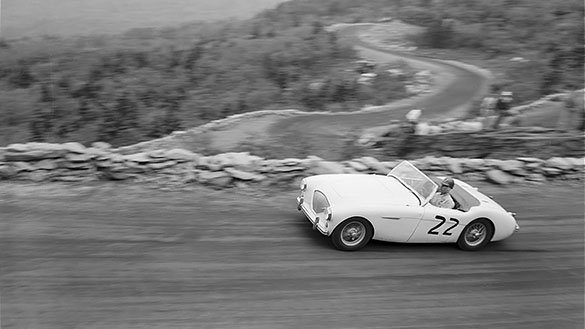
On a June day in 1953, nine months after Hugh Morton and his team at Grandfather Mountain dedicated the Mile High Swinging Bridge, a small group of sports car enthusiasts from the Greensboro-Burlington-Winston chapter of the Sports Car Club of North Carolina gathered on the road at the foot of the historic mountain. They, along with Morton, wanted to see how fast they could climb the winding two-and-a half-mile road with an elevation increase of 1,000 feet during a race to the top against the clock. An average tourist driver would take about ten minutes to maneuver the 28-turn trip to the Swinging Bridge, but these sports cars, with their tremendous horsepower, could do it much faster. On that June day a Jaguar made the run in 4 minutes, 55 seconds—and the idea for a “hill climb” caught on. A new event would be added to the Grandfather Mountain summer calendar.
In late May, 1954, Hugh Morton sent out the following press release:
Two events you’re likely to enjoy take place at Grandfather Mountain the weekend of June 5-6. . . The mile-high kite flying contest was the idea of Fox-Movietone News and has met with such enthusiasm that now it promises to be a show of great proportions . . . . A sports car race is something that was tried with great success last year at Grandfather on a relatively small scale . . . this year the Greensboro-Burlington-Winston chapter of the Sports Car Club of North Carolina will be joined by MG and Jaguar fanciers from the Charlotte area and all over for a really big affair. The Grandfather Mountain road gains elevation in a hurry and has one or two curves, so it’s a natural for the sports car folks. Mystery-thriller writer Mickey Spillane, who sells by the millions those books your wife won’t let you read, is scheduled for pace-setter in the race.
On Saturday night, June 5, 1954, Spillane made the 400-mile trip from Myrtle Beach in time for the first run up the mountain, scheduled for 10 o’clock on Sunday morning. Thirty-four drivers competed, and a crowd estimated at 1,000 cheered them on. At the end of the day Maurice Poole, Jr., from Greensboro, was the overall winner driving a Riley touring car in a record time of 3 minutes, 55 seconds.
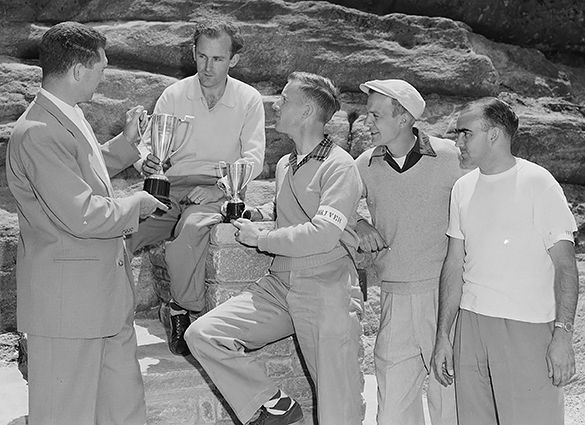
A year later, the third annual Grandfather Mountain Hill Climb was staged on June 3rd and 4th, 1955—third annual if you count that unofficial run in 1953. This time sixty drivers were on hand with more than twenty-five of them driving Jaguars. ’54 winner Maurice Poole was the man to beat on this day, but he had changed his winning Riley for a ’55 modified Jag. When the dust had settled on Sunday afternoon, a Chevrolet-powered V8 MG driven by Jimmy Kaperoms had set a new record of 3 minutes, 33 seconds.
In the June ’56 hill climb, Winston-Salem’s Ed Welch, driving a Mercury-powered Bob Davis Special set yet another record over the crushed-gravel course, climbing the hill with a time of 3:25.3. Welch, having won three class races at Grandfather over the years, was awarded the Dennis Strong Memorial Trophy, which was named for one of the founders of the Grandfather Mountain race. Strong was killed in 1953 during a sports car race in Greensboro.
Almost 100 drivers registered for the 1957 hill climb, and Hugh Morton brought in his old friend from Morganton, golfer Billy Joe Patton to make the trophy presentations. Helping Patton was “Queen of the Hill Climb” Betty Jean Goodwin from Spartanburg, South Carolina, a Wake Forest coed. The ’57 winner was once again Ed Welch and again he set a record of 3:23.1 to the delight of the more than 3,000 spectators.
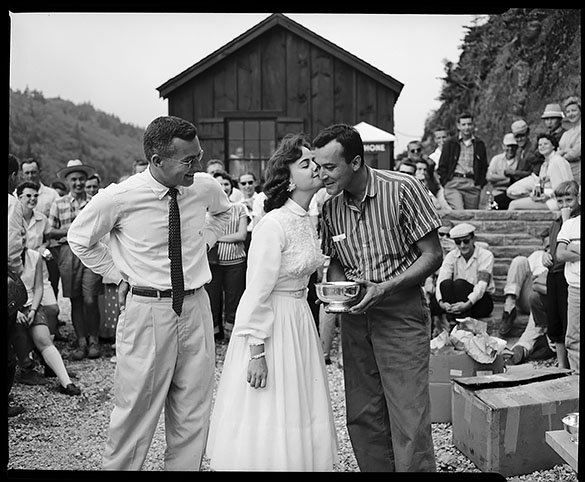
A unique situation occurred at the 1958 hill climb: the new winning driver drove the defending champion’s old car. When Billy Joe Patton, along with 1958 Queen Judy Kincaid, presented the winning trophy to Phil Styles of Burnsville, he stood beside that same Mercury-powered Davis Special that Ed Welch had driven in ’57. Styles continued the tradition by setting a record run of 3:19.9.
The first weekend in June of 1959 proved to be a busy time at Grandfather Mountain. The Carolina Golf Writers Association held a tournament at the Linville Country Club and that was followed by a second tournament sponsored by the Carolinas Golf Association pros—and fifty drivers ran the Grandfather Mountain Hill Climb, now in its sixth year. The late arrival of the radio car delayed the start of the race, and overcast skies and windy conditions prevented a record run, but 5,000 spectators saw Phil Styles of Burnsville power his Davis Special to a winning time of 3:28 to receive the Julian Morton Cup by Queen Norma Jean McMillan.
The 1960 race was interrupted by showers, but the 4,000 spectators didn’t seem to mind as they cheered Austin-Healey driver J. T. Putney from Asheville as the overall winner. Hill Climb Queen Jane Joyner from Raleigh, and UNC football legend Charlie Justice presented the Julian Morton Cup to Putney.
The Grandfather Mountain Hill Climb became the oldest sports car event in the south with the 1961 event as drivers from six states competed. The estimated crowd of 6,000 saw a whopping 17.8 seconds clipped off Phil Styles’s 1958 record. Orlando, Florida driver Bill Stuckworth set the new mark of 3:02.1 driving a Siata-Corvette.
The 1962 Grandfather Mountain Hill Climb was originally scheduled for June 9-10, but on May, 11, 1962, Hugh Morton made an important announcement. “We have been pleased with the sponsorship of the sports car hill climb at Grandfather Mountain for the past eight years, and are quite relieved that in those years we have not had an accident in which either driver or spectator was seriously injured. We have decided to quit the event while we are ahead.
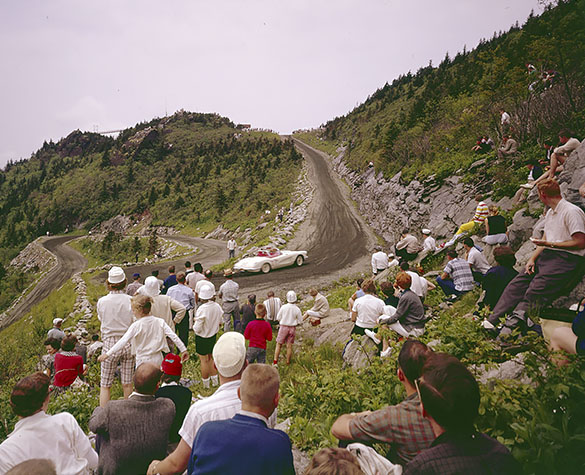
“As the Grandfather Mountain climb became more popular, it became increasingly difficult to run it without having spectators too close to the road while the sports cars were racing against the clock at high speeds and spectators were climbing to precarious places to watch the event. . . . Our principal concern has always been that a thoughtless spectator could be seriously hurt, since we could not control spectator behavior along the two and a half mile road leading to the parking area near the Mile High Swinging Bridge.”
In early June, the Sports Car Club of America announced the scheduling of a four-hour endurance race for June 10, 1962 in Columbia, South Carolina to replace the Grandfather Mountain event.
Twenty four years later, in the spring of 1985, Morton was approached by a group of sports car drivers from the Chimney Rock Hill Climb, wanting him to revisit the climb at Grandfather. Although he knew it would be a challenge, Morton wanted to help the guys so he set up a modified course and scheduled an early June race date. The new course would be one-mile in length from the parking lot at the habitat area to the parking lot at the Mile High Swinging Bridge. It would have a vertical rise of 600 feet, and feature thirteen turns that sportswriter John Davison described as ranging from fast sweepers to first gear “creepers.”
Race day dawned wet and foggy, but Mike Green, driving a “Chap-Mazda Special” was able to post a winning time of 1:13.982 on the short course. As Morton suspected, the day was far from a success. Grandfather Mountain’s Harris Prevost, Vice President of the Grandfather Mountain Stewardship Foundation, described that race day situation:
“Obviously, we could not have anyone else on the summit road when they were racing. Thus, everywhere there was a chance a car could pull out on the road, we had to have someone there to keep them where they were . . . people at the two picnic areas, Black Rock Parking Lot, Nature Museum and Top, all had to stay in place until all the cars made their run. This did not sit well with our guests, to say the least. . . . Being told to wait 30-45 minutes did not work.”
Before the race day ended, discussions were already underway about the future of the race. It was agreed to move the 1986 event to a September time when normal Grandfather traffic would be less. The September time was a goodwill gesture but it didn’t work much better, plus the number of spectators had dwindled to just a few friends of drivers. So, the event was once again discontinued and those Chimney Rock drivers moved to Beech Mountain where they started a new event.
In 2014, Arcadia Publishers of Charleston, South Carolina published a Grandfather Mountain book as part of their “Images of America” series. On the front cover, the editors chose an action photograph of the Bob Davis Special at one of the 1950s climb to the top. (The image was taken by Hugh Morton photographic contemporary Sebastian Sommer).
The Morton collection finding aid lists more than 300 photographs of the Grandfather Mountain Sports Car Hill Climb, 17 of which are viewable online.
Correction: 20 February 2018
The misspelling of John Davison’s name has been corrected. It is misspelled as “John Davidson” in the September 1985 issue of Auto-X Magazine, page 36, which is the source for the misspelling.
Photographs by Hugh Morton: an Uncommon Retrospective in final weeks at Charlotte Museum of History
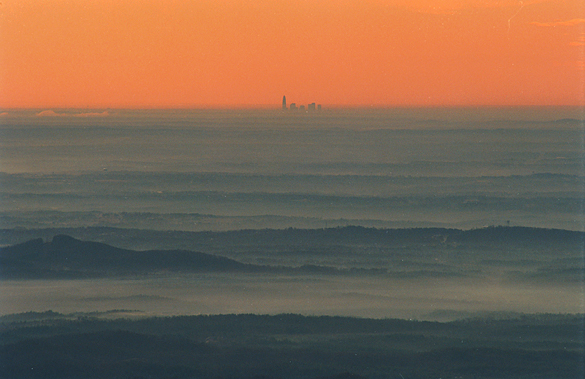
Photographs by Hugh Morton: an Uncommon Retrospective is currently installed at the Charlotte Museum of History though September 30th. I will be there this Saturday, the 19th, for my exhibition talk titled “Hugh Morton’s Rise to his Photographic Peak.” at 1:00. If you are in the neighborhood, please visit the museum and say hello!
Looking back at our common future
Happy Earth Day 2015. Hugh Morton photographed in many places around the globe, but the planet itself was not one of them . . . at least not from outer space. Looking for an image to post for Earth Day, I searched the online collection for “earth” . . . then “globe” . . . then “global.” The last search term led to today’s post.
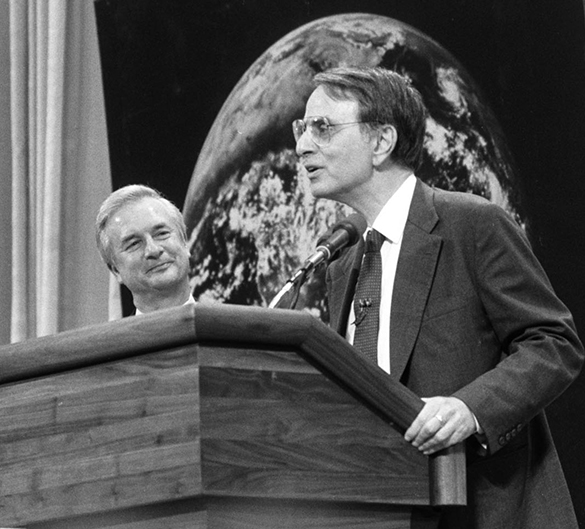
Since 1986 the Institute for Emerging Issues at North Carolina State University has held an annual Emerging Issues Forum. Hugh Morton attended the forum in February 1990 when the theme was “Global Changes in the Environment: Our Common Future.” According to the program published after the forum, there were approximately 1,500 attendees. Featured speakers included Al Gore, 45th Vice President of the U.S.; Carl Sagan, former director of the Laboratory of Planetary Studies at Cornell University; Steve Cowper, former governor of Alaska; and Madeline Kunin, former governor of Vermont.
After searching through the Morton collection finding aid to see what other years he may have attended the forum, it appears that was the only time he went—or at least photographed, but I cannot imagine Morton attending such an event and not taking at least one photograph. There are 68 negatives from the 1990 forum, filed in three locations in the collection with the following descriptions:
- Roll Film Box P081/35BW-5, Envelope 2.6.270-5-1: Gore, Al at NCSU Emerging Issues Forum (with Steve Cowper, etc.), 1990, Black and white 35mm roll film negatives, 6 images;
- Roll Film Box P081/35BW-6, Envelope 2.6.602-5-1: “Sagan, Carl, Governor Jim Hunt, North Carolina State” (Emerging Issues Forum?), 1990s, Black and white 35mm roll film negatives, 6 images; and
- Roll Film Box P081/35BW-8, Envelope 2.8.7-5-11: Emerging Issues Forum, North Carolina State University, 8-9 February 1990, Black and white 35mm roll film negatives, 56 images.
Scans made from eight of these negatives can be seen in the online collection of Morton photographs.
This Saturday is a good day to go to New Bern

If you live in the New Bern area, there’s still time to see the exhibition “Photographs by Hugh Morton: An Uncommon Retrospective” at Tryon Palace—and tomorrow, Saturday February 7th, would be a good time to visit. Why . . . ?
- The historic sites have free admission! Saturday is “Free Day: Working 9 to 5” at Tryon Palace. Normally tickets are $20.00, but on Saturday you can explore the Governor’s Palace, historic homes, gardens and the nearby New Bern Academy Museum for no admission fee. Trade demonstrations will allow you to explore jobs and trades from eastern North Carolina’s past.
- There will be discounted passes to the North Carolina History Center’s permanent exhibits.
- I will be giving my talk, “Hugh Morton’s Rise to his Photographic Peak,” at 2:00.
If you are a UNC alumnus, there is also a special “meet-and-greet” reception (details and RSVP) at 1:00. The gathering, sponsored by the University of North Carolina Alumni Association, will provide a chance for alumni to mingle and socialize, and I’ll l be there to talk and answer questions informally about the Morton collection, the Bayard Wootten photographic collection (she was a New Bern native), the North Carolina Collection Photographic Archives, the Wilson Special Collections Library, or photographs in general.
Can’t make it tomorrow? No worries . . . yet. The Hugh Morton exhibition will be on display at Tryon Palace through February 22nd.
Hugh Morton retrospective at Tryon Palace in New Bern
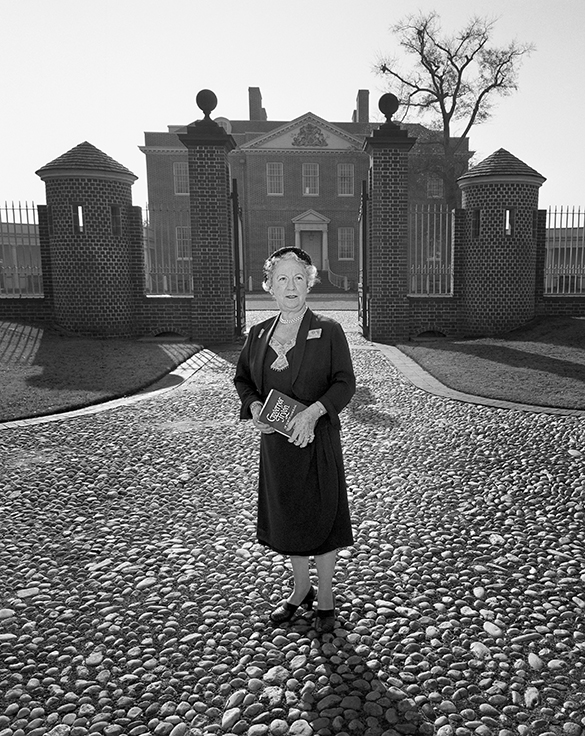
The exhibition “Photographs by Hugh Morton: An Uncommon Retrospective” opens for its fourth venue on Saturday, January 10th at the North Carolina History Center at Tryon Palace, 529 South Front Street in New Bern, NC. The exhibition runs through February 22nd, which is just a few days after what would have been Morton’s 94th birthday.
Current plans call for me to give my accompanying lecture “Hugh Morton’s Rise to His Photographic Peak” and a gallery tour on Saturday, February 7th—details to follow once they become finalized.
Nixon and Graham though the voice of Haldeman

Yesterday on WUNC’s program The State of Things, host Frank Stasio interviewed Carolina Public Press reporter Jon Elliston, who has listened to the H. R. Haldeman audio diaries recently released by the Richard M. Nixon Presidential Library. On Wednesday, November 12th, the Carolina Public Press website published Elliston’s article about the Billy Graham–Richard Nixon alliance as revealed on Haldeman tapes. During the interview, Stasio and Elliston briefly discuss Haldeman’s diary entry for “Billy Graham Day” in Charlotte on October 15, 1971.

As you might expect, Hugh Morton was there. He was located stage left, slightly elevated and slightly forward of the podium—either seated in the audience just behind the press photographers platform or on the platform behind the television cameras. He photographed using 35mm cameras loaded with black-and-white negative and color slide films, and was switching lenses. Two of Morton’s color images appear in the book Making a Difference in North Carolina; those two original slides, however, are not in the Morton collection.
Several of the black-and-white negative frames are double exposures, but it’s difficult to say if they were intentional or accidental. Broken sprocket holes on the film suggest Morton experienced a camera failure during the event. Below is one of the double exposures that produced an interesting result: Nixon and Graham’s sculpted face (from an unveiled historical marker) appear to be looking at each other.
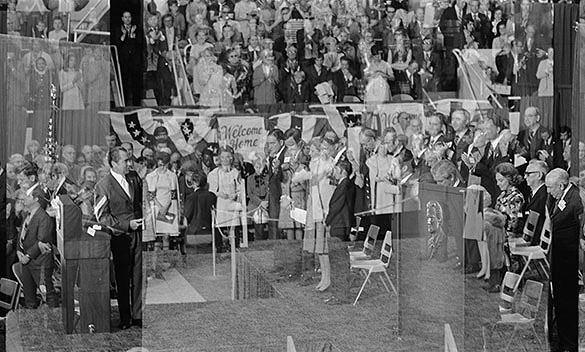
Postscripts
In recent months we’ve run two blog posts related to this time period, when Hugh Morton was an undeclared candidate for governor in the Democratic Party: the Governor’s Down-East Jamboree in Atlantic Beach in mid September, and The National 500 NASCAR race on October 10th in Charlotte. Billy Graham Day was just five days after the race.
In addition to Morton’s photographs of the Billy Graham Day, the North Carolina Collection Photographic Archives also holds forty-two 35mm slides by Charlotte Observer Chief Photographer Don Sturkey.
Richard Nixon’s speech can read at University of California, Santa Barbara’s “The American Presidency Project” website.
In his own words: Johnpaul Harris, artist and dear friend
Today, November 5, 2014 marks a very special anniversary on the UNC campus. It was ten years ago, on a beautiful Hugh Morton photo-post-card-day, that the magnificent Charlie Justice statue was dedicated just outside the Justice Hall of Honor at the Kenan Football Center. On that day, the dedication ceremony included several people representing the university, plus friends and teammates—but we didn’t hear from the man who made it all possible: sculptor Johnpaul Harris. So, today on the tenth anniversary, Morton Collection volunteer Jack Hilliard shares some of Harris’ thoughts about that day and his work with his friend Hugh Morton.
I didn’t want to make him [Justice] too much of a pretty boy, but I didn’t want to make him this mean, killer football player either. —Johnpaul Harris in the February 6, 2005 issue of the High Point Enterprise.
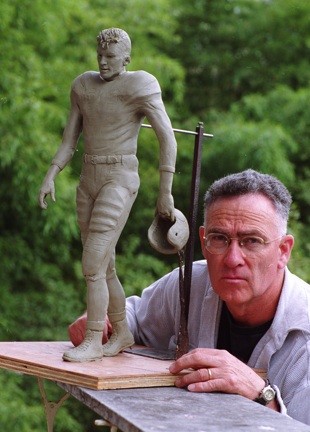
Shortly after Charlie Justice’s death on October 17, 2003, teammate Joe Neikirk approached Hugh Morton with an idea for a statue. Morton, who had worked with his friend Sculptor Johnpaul Harris on other projects like the Mildred and cubs statue and the deer habitat at Grandfather Mountain, immediately called his friend to see if he would be interested in a football statue. Harris described his reaction in a 2005 letter to Hugh Morton:
“I probably more than anybody know how Coach (Carl) Snavely felt when Charlie turned up at Chapel Hill. If it wasn’t a gift from God for Snavely it was certainly one for me. You called me late in 2003 to see if it was the kind of project I would be interested in. I think you knew the answer, but maybe not the extent of it. It was the ultimate project for a man who was an OK football player who in high school knew nothing of Charlie Justice other than that he was the first famous ball player that I or any of my generation remember.”
In an interview with Annette Dunlap in the November 19, 2004 issue of Asheboro’s The Courier-Tribune, Harris said, “I jumped on it.” Morton then became the linchpin between the university and Harris. “There’s a lot of red tape established on the Chapel Hill campus for the installation of artworks,” Harris continued in his Dunlap interview. “I just had to wait for it to run its course.”
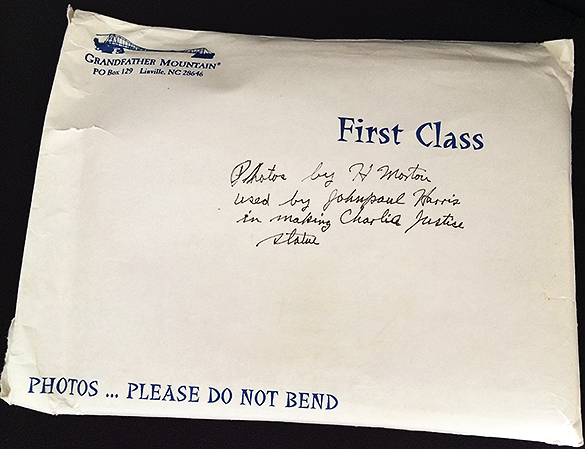
While he waited, Harris and Morton started to work on the project . . . as Harris continues in his letter to Morton:
“. . . you started sending pictures from your fantastic collection of Carolina images. I treasure each one for several reasons, but at the time they were just full of information that was vital to the project. When I asked for more particular angles, you always came through for me. It was like Christmas every time I opened the mail box to find a big white envelope with Grandfather Logo in the corner. I had enough information to do the job, but I never saw a picture that didn’t further my understanding of who Charlie Justice was.
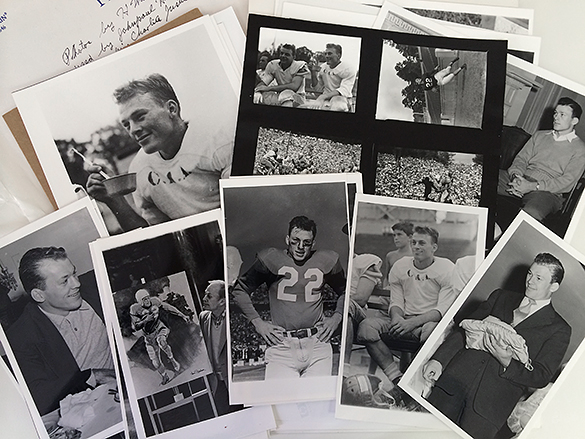
“. . . Then one day the phone rang and it was Willie Scroggs (Senior Associate Athletic Director for Facilities at UNC) saying that they wanted me to do the Charlie Justice statue. It was the sweetest moment of my life as a sculptor, until the team reviews, and the unveiling.”
It was now time for serious work. Harris and Morton’s UNC committee selected the walking pose rather than an action shot and Harris prepared a 26-inch-model for Athletics Director Dick Baddour to review—a review that came on the day of the 2004 Blue-White game at Kenan Stadium. Harris was a special guest at the game.

Next up, on June 1, 2004, was the first of two Justice-era player reviews. This was my introduction to Johnpaul Harris. We have remained good friends and get together for lunch every few weeks.
Harris continues with his letter to Morton:
I thought Charlie looked pretty good when the teammates came over to critique it.
The players offered suggestions and Harris took lots of notes. Three weeks later, the players had a second review in Harris’ Asheboro studio. Harris made final adjustments, then a final mold before Charlie was off to the foundry. On January 7, 2005 Johnpaul Harris was a guest on the UNC-TV program North Carolina People with William Friday. Harris explained the process of taking four, 30-gallon-barrels of North Carolina clay and making it into a work of art to be cast at the foundry.
As Harris wrote to Morton,
It felt really good to have Charlie in place and out of my hands for a change. I still enjoy seeing the pictures you made that day.
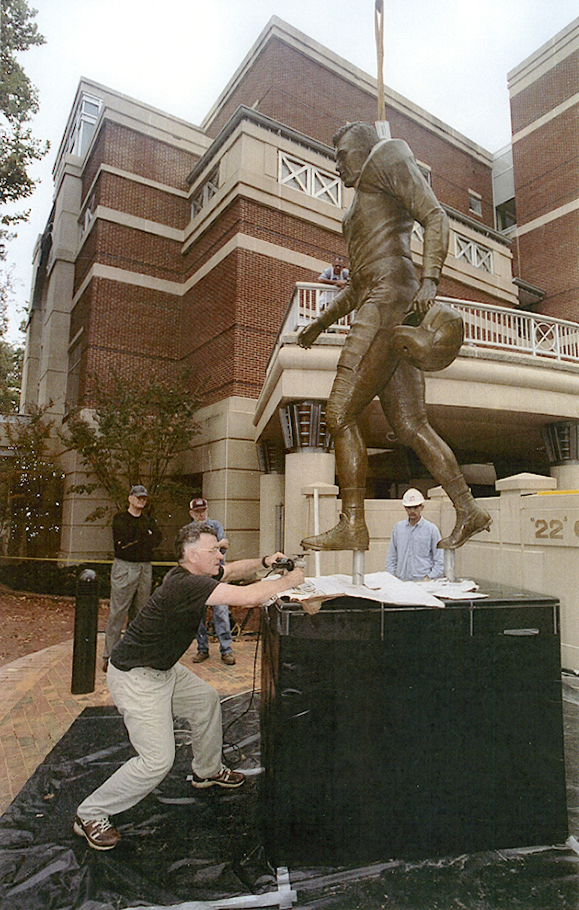
On Tuesday morning, November 2, 2004, I got a call from Hugh Morton. He said, “We’re going to put the Charlie Justice statue in place tomorrow morning. We’d like to have you there.”
Wednesday, November 3rd was a beautiful day in Chapel Hill as Johnpaul Harris directed a crew from Architect Glenn Corley, and placed the 950 pound, 8 foot, 6 inch work of art into its final position. When all of the installation work was done, Hugh Morton said to Harris, “You did a magnificent job. It looks just like Charlie.”
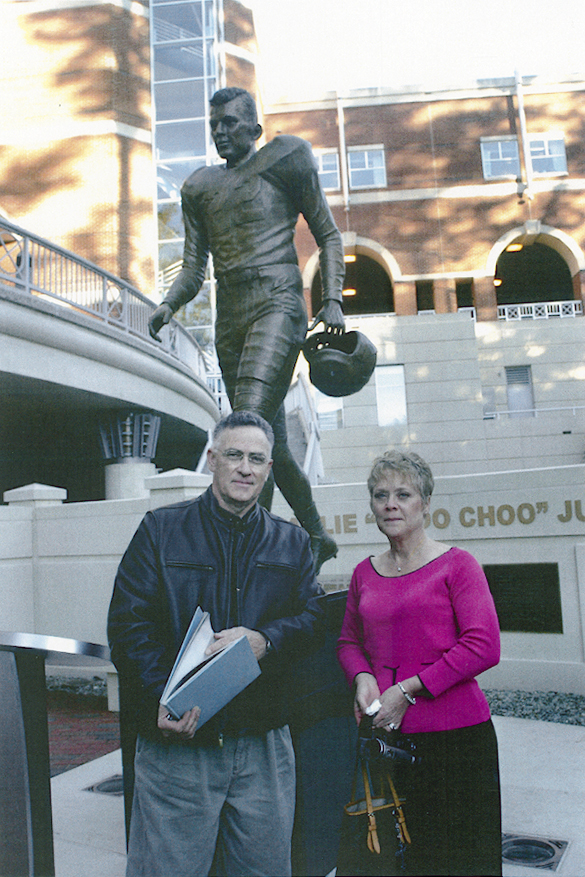
On November 5, 2004 the Morton-Harris team was once again prepared to impress with the dedication of the Charlie Justice statue.
In his letter to Morton, Harris continued:
For me, days don’t come any better than unveiling day. The weather was perfect. There were so many friends and family, there was not enough time to do all the visiting I would have liked, not to mention catching up with Charlie’s teammates that I have come to know.
“It was great to see everybody enjoying Charlie after the unveiling. Barbara Crews (Charlie and Sarah’s daughter) seemed to enjoy it more than anyone else and for longer periods. I saw her staring up into the face and remarking that she hadn’t seen her Daddy from that perspective since she was a little girl. I’m sure it sparked a deep well of memories for her. She also mentioned that she had never seen his hands as open as they were, since they had suffered so many injuries (probably from pro ball). Thanks, Hugh, for introducing us. I did miss getting the definitive picture of you and me standing before the thing that we had spent so much time and energy on in the past two or three seasons. Maybe we can do that on some nice crisp Saturday before a home game.”
Unfortunately, that pictured never got taken.
I thought my football life was behind me. I never expected to tell anyone that I had been an All Central Tar Heel Conference player. But the most perfect completion of the circle of my gridiron days has been realized. A pretty good footballer from Troy (NC) was chosen to honor in bronze the memory of the greatest football legend of the 20th century from North Carolina. I was part of the team that was Charlie’s team and by extension, I became a part of Charlie’s team. Finally, I had to live up to your faith in me and then if there was anything else I had to satisfy my own demands for my work. Thank you for making it all possible. Without the superb record that you shared with me, the work would have come far short of what we achieved. And thank you for your friendship, which started with our collaboration on Mildred. For my part I know that it will never end.
—Johnpaul Harris, February 5, 2005
Epilog
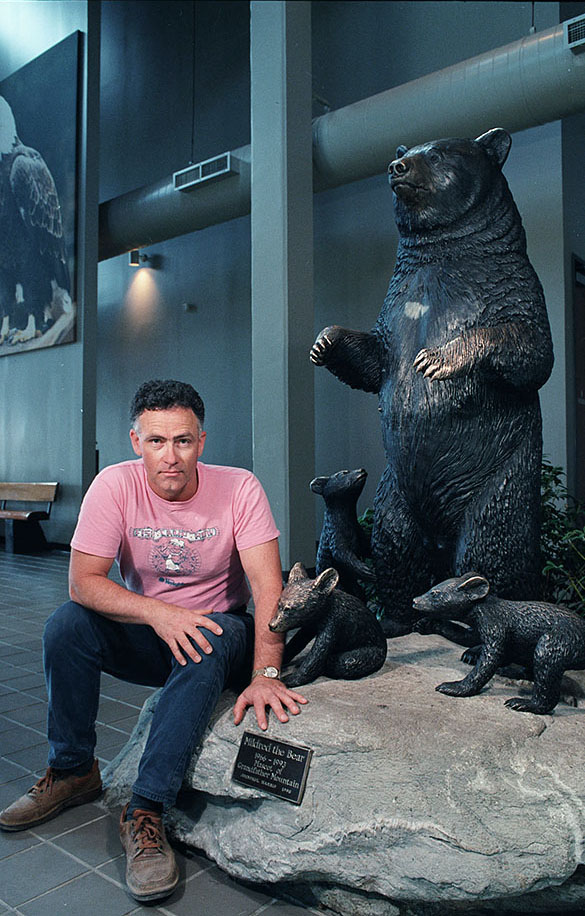
Morton and Harris had worked together about fifteen years before the Justice statue when Morton commissioned Harris to create a statue of Mildred the Bear, the loveable people-friendly mascot of Grandfather Mountain, with her cubs. That effort is now in the Grandfather Mountain Nature Museum. During a 2005 interview with Jimmy Tomlin in the High Point Enterprise, Harris remembered working inside Mildred’s habitat getting precise measurements. “She was great. Of course, they were keeping her happy with apple pieces while I was in there.” Harris also got to pet the cubs. “They’d put their paws around your neck and lick you in the face, just like a puppy.”
In addition to Mildred and Charlie, you can see other Johnpaul Harris sculptures at the North Carolina Zoo in Asheboro where there is an 11-foot Rhino statue. UNC Alumnus Charles Loudermilk funded for the city of Atlanta a Johnpaul Harris statue of former mayor Andrew Young for the city’s Walton Spring Park (now Andrew Young Plaza), installed in 2008.
Postscript
As Harris was driving his truck home from Chapel Hill following the review of his Justice model in May of 2004, the odometer tripped 222,222.2. When Johnpaul told Hugh the story about the 2s, He smiled and said, “Maybe somebody was trying to tell you something.”
I agree with Hugh. I feel sure that #22 saw that and smiled.
A Hall for All . . . Old, New, and Renovated
Nine years ago on September 8, 2005, the “new and improved” Memorial Hall on the UNC campus was celebrated with a grand re-opening weekend. On this special anniversary, Morton Collection volunteer, Jack Hilliard, takes a look back at this iconic building.
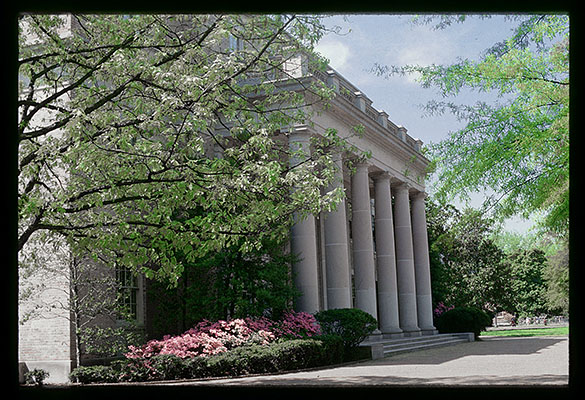
It became painfully clear during UNC’s commencement weekend of 1883 that Gerrard Hall was too small for Carolina’s growing family. Afterward, officials quickly drew plans for a new 4,000-seat building on a site just west of Gerrard to be named Memorial Hall in honor of David Lowry Swain, President of the University from 1835 until 1868, and North Carolina’s Governor from 1832 until 1835. Soon after construction began, however, the university expanded the memorial honor to include UNC alumni who died in the Civil War as well as additional outstanding Carolina alumni and North Carolina citizens.
A lagging fund raising campaign and cost overruns plagued the project, but finally construction was completed and Memorial Hall was dedicated on June 3, 1885. A project that had an original estimated cost of $20,000 had a final cost about $45,000. (That’s $1.074 million in today’s dollars.) Despite a poor architectural design and major acoustical problems, the facility served the University until 1929. In 1896, after the campus gymnasium became a dining hall, Memorial Hall was used as a gymnasium and remained in that capacity until Bynum Gym was opened on May 29, 1905. By 1929, Memorial Hall had suffered major damage to its foundation. The building was declared unsafe and torn down.
On January 18, 1930 John Sprunt Hill, speaking for the University building committee, recommended “the erection of a modern fireproof building of greater dignity, to replace old Memorial Hall.” The State Emergency Fund provided $150,000 to construct a new structure on the site of the old hall. The new Memorial Hall was completed in mid-summer 1931 at a final cost of $182,000 ($2.6 million in today’s dollars). On University Day, October 12th, the new facility was dedicated and the building was presented to University trustee, John Sprunt Hill, by North Carolina Governor O. Max Gardner.
The first performance on stage in the new building was dancer Carola Goya. For almost 30 years, Memorial Hall served the University and Chapel Hill community well with entertainment, freshman orientations sessions, awards nights, baccalaureate exercises, commencement ceremonies, lectures, pep rallies, the North Carolina Symphony, and even a beauty pageant in 1966. The list of those appearing on stage reads like a who’s who . . . Louis Armstrong, Dave Brubeck, Montovani, Marcel Marceau. On January 31, 1942, First Lady Eleanor Roosevelt visited campus as keynote speaker at a jointly-sponsored International Student Service-Carolina Political Union Conference on “Youth’s Stake in War Aims and Peace Plans.”

Over the years, Hal Holbrook with his “Evening with Mark Twain” made several appearances as did Flamenco guitarist Carlos Montoya. At the height of the folk music era Joan Baez, and Peter, Paul and Mary stopped by. In 1987 Charles Kuralt and Loonis McGlohon performed “North Carolina is My Home.” A speakers list includes, Billy Graham, Terry Sanford, and Ted Kennedy. Walter Cronkite and Dan Rather have been featured at the Nelson Benton Memorial Lecture series sponsored by the School of Journalism and Mass Communications, and coaches Carl Snavely, Wallace Wade, and Dean Smith were featured as part of an ongoing series on sportsmanship. On May 13, 1989 as part of Graduation/Reunion Weekend, Hugh Morton presented a slide show from Carolina’s Golden Age to a near-full house in the storied facility.

When UNC’s Clef Hangers completed their annual spring concert on April 20, 2002 the doors to the ‘Great Hall” were closed for a three-year major building transformation. A partnership between the State of North Carolina and hundreds of generous donors funded the $18 million project. The new Memorial Hall now has air conditioning, seven dressing rooms, new marble lobby floor, and a new stage that is twice the size of the original. The auditorium seating configuration is improved with wider aisles and better sight lines.
On September 8, 2005 a ribbon-cutting ceremony kicked off the Grand Reopening Gala that featured stars Tony Bennett, Itzhak Perlman, and Leonard Slatkin—plus our own North Carolina Symphony. Following the hall’s renovation, Carolina Performing Arts has continued to offer world-class performances in music, dance and theater, and the caliber of performers picked up right where it had left off before closing with Bonnie Raitt, Yo-Yo Ma, Nanci Griffith, and Vince Gill. In 2005, National Public Radio’s “Wait, Wait, Don’t Tell Me!” originated a nation-wide broadcast from Memorial Hall, and in 2009 the world-renowned Bolshoi Ballet performed a first ever concert in the Southeast.
The future is just as bright for Memorial Hall. Performances this season include the Pittsburgh Symphony under the direction of Manfred Honeck, and Wynton Marsalis and the Lincoln Center Jazz Orchestra. And of course the Holidays would not be complete without the Carolina Ballet’s performance of “The Nutcracker.”
